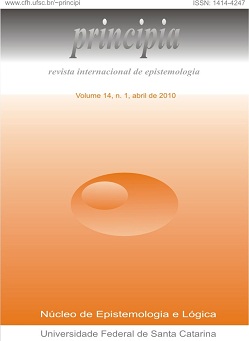Aristotle’s Theory of Deduction and Paraconsistency
DOI:
https://doi.org/10.5007/1808-1711.2010v14n1p71Abstract
In the Organon Aristotle describes some deductive schemata in which inconsistencies do not entail the trivialization of the logical theory involved. This thesis is corroborated by three different theoretical topics by him discussed, which are presented in this paper. We analyse inference schema used by Aristotle in the Protrepticus and the method of indirect demonstration for categorical syllogisms. Both methods exemplify as Aristotle employs classical reductio ad absurdum strategies. Following, we discuss valid syllogisms from opposite premises (contrary and contradictory) studied by the Stagerian in the Analytica Priora (B15). According to him, the following syllogisms are valid from opposite premises, in which small Latin letters stand for terms such as subject and predicate, and capital Latin letters stand for the categorical propositions such as in the traditional notation: (i) in the second figure, Eba,Aba ` Eaa (Cesare), Aba, Eba ` Eaa (Camestres), Eba, I ba ` Oaa (Festino), and Aba,Oba ` Oaa (Baroco); (ii) in the third one, Eab,Aab ` Oaa (Felapton), Oab,Aab ` Oaa (Bocardo) and Eab, Iab ` Oaa (Ferison). Finally, we discuss the passage from the Analytica Posteriora (A11) in which Aristotle states that the Principle of Non-Contradiction is not generally presupposed in all demonstrations (scientific syllogisms), but only in those in which the conclusion must be proved from the Principle; the Stagerian states that if a syllogism of the first figure has the major term consistent, the other terms of the demonstration can be each one separately inconsistent. These results allow us to propose an interpretation of his deductive theory as a broad sense paraconsistent theory. Firstly, we proceed to a hermeneutical analysis, evaluating its logical significance and the interplay of the results with some other points of Aristotle’s philosophy. Secondly, we point to a logical interpretation of the Aristotelian syllogisms from opposite premises in the antilogisms method proposed by Christine Ladd-Franklin in 1883, and we also present a logical treatment of the Aristotelian demonstration with inconsistent material in the paraconsistent logics Cn, 1 _ n _ !, introduced by da Costa in 1963. These two issues seem having not yet been analysed in detail in the literature.
Downloads
Published
Issue
Section
License

Principia http://www.periodicos.ufsc.br/index.php/principia/index is licenced under a Creative Commons - Atribuição-Uso Não-Comercial-Não a obras derivadas 3.0 Unported.
Base available in www.periodicos.ufsc.br.



